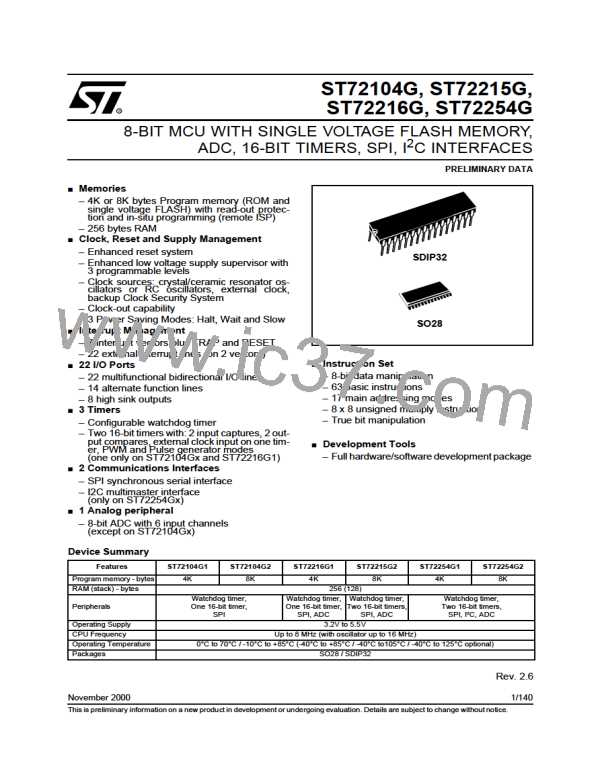ST72104G, ST72215G, ST72216G, ST72254G
12.2 16-BIT TIMER
12.2.1 Introduction
12.2.3 Functional Description
12.2.3.1 Counter
The timer consists of a 16-bit free-running counter
driven by a programmable prescaler.
The main block of the Programmable Timer is a
16-bit free running upcounter and its associated
16-bit registers. The 16-bit registers are made up
of two 8-bit registers called high & low.
It may be used for a variety of purposes, including
measuring the pulse lengths of up to two input sig-
nals (input capture) or generating up to two output
waveforms (output compare and PWM).
Counter Register (CR):
Pulse lengths and waveform periods can be mod-
ulated from a few microseconds to several milli-
seconds using the timer prescaler and the CPU
clock prescaler.
– Counter High Register (CHR) is the most sig-
nificant byte (MS Byte).
– Counter Low Register (CLR) is the least sig-
nificant byte (LS Byte).
Some ST7 devices have two on-chip 16-bit timers.
They are completely independent, and do not
share any resources. They are synchronized after
a MCU reset as long as the timer clock frequen-
cies are not modified.
Alternate Counter Register (ACR)
– Alternate Counter High Register (ACHR) is the
most significant byte (MS Byte).
– Alternate Counter Low Register (ACLR) is the
least significant byte (LS Byte).
This description covers one or two 16-bit timers. In
ST7 devices with two timers, register names are
prefixed with TA (Timer A) or TB (Timer B).
These two read-only 16-bit registers contain the
same value but with the difference that reading the
ACLR register does not clear the TOF bit (Timer
overflow flag), located in the Status register (SR).
(See note at the end of paragraph titled 16-bit read
sequence).
12.2.2 Main Features
■ Programmableprescaler:fCPU dividedby2, 4or8.
■ Overflow status flag and maskable interrupt
■ External clock input (must be at least 4 times
slowerthan theCPUclockspeed)with thechoice
of active edge
■ Output compare functions with:
– 2 dedicated 16-bit registers
– 2 dedicated programmable signals
– 2 dedicated status flags
Writing in the CLR register or ACLR register resets
the free running counter to the FFFCh value.
Both counters have a reset value of FFFCh (this is
the only value which is reloaded in the 16-bit tim-
er). The reset value of both counters is also
FFFCh in One Pulse mode and PWM mode.
The timer clock depends on the clock control bits
of the CR2 register, as illustrated in Table 13 Clock
Control Bits. The value in the counter register re-
peats every 131.072, 262.144 or 524.288 CPU
clock cycles depending on the CC[1:0] bits.
– 1 dedicated maskable interrupt
■ Input capture functions with:
– 2 dedicated 16-bit registers
– 2 dedicated active edge selection signals
– 2 dedicated status flags
The timer frequency can be f
or an external frequency.
/2, f
/4, f
/8
CPU
CPU
CPU
– 1 dedicated maskable interrupt
■ Pulse Width Modulation mode (PWM)
■ One Pulse mode
■ 5 alternate functionson I/O ports (ICAP1, ICAP2,
OCMP1, OCMP2, EXTCLK)*
The Block Diagram is shown in Figure 26.
*Note: Some timer pins may not be available (not
bonded) in some ST7 devices. Refer to the device
pin out description.
When reading an input signal on a non-bonded
pin, the value will always be ‘1’.
42/140

 ETC [ ETC ]
ETC [ ETC ]